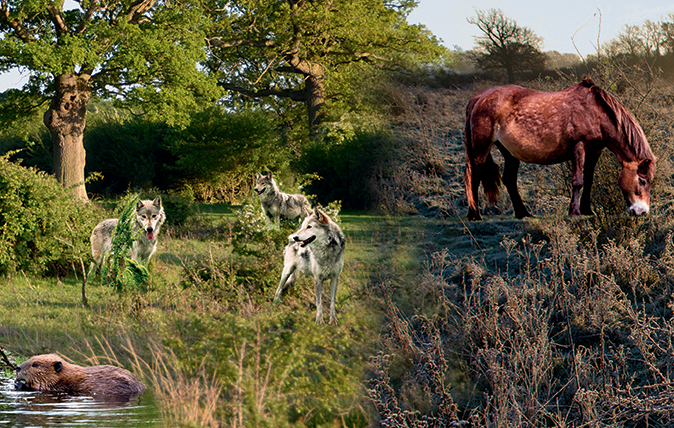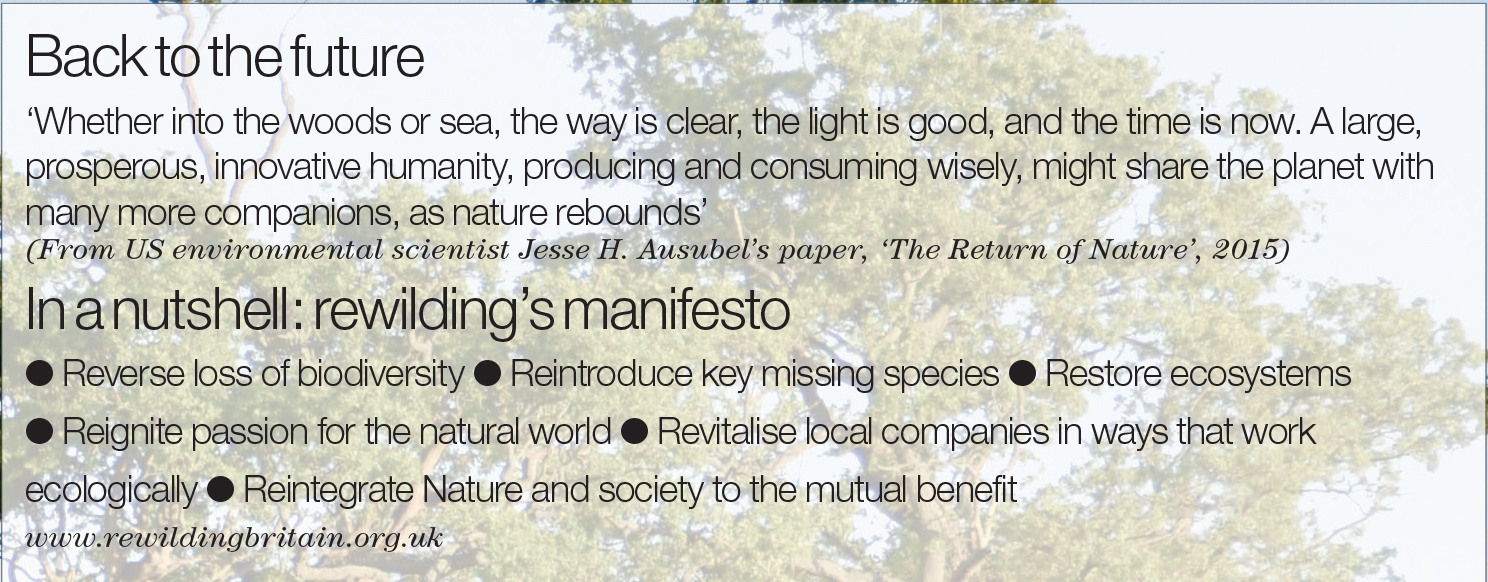Is it time to run wild?
Few people would deny that the idea of a wilder Britain is exhilarating, but isn’t it just a dream for a country such as this?


Is rewilding Britain really possible?
Twenty years ago, a ballonist floating over Knepp Castle in West Sussex would have looked down on conventional yellow and green squares bordered by tidy, dark-green lines. The view today is almost foreign in its differentness, as random blotches of scrub intersperse, like the African bush, with free-moving herds of grazing animals.
This is rewilding, the hot, and sometimes contentious, conservation topic of the day. It has been happening over the past 15 years at Knepp, after Sir Charles Burrell, heir to the 800-year-old estate, realised that his farm overdraft was blossoming at about the same rate as his wildlife count was shrinking.
Parts of the estate now resemble a Jurassic Park set and, I discover, the last Country Life writer to visit, nearly 10 years ago (November 15, 2007), used exactly that simile. Animals chosen for their close resemblance to ancient beasts—Longhorn cattle, Exmoor ponies, fallow deer (and roe and red) and (unseen) Tamworth pigs—give the place a dream-like quality. The ugly confluence of the A272 and A24 is less than a mile away, yet, in this messy, brambly jungle, silent save for a distant pheasant (it’s a dull February day), the atmosphere is anticipatory as if a long-extinct animal might roar, thrillingly, out of the scrub.
It's obvious that this dramatic change is only possible when income streams other than farming are available. Knepp has some 100 rental properties, makes six-figure sums from sales of organic meat, offers 'glamping' with an edge and attracts trophy hunters prepared to pay good money for the specially selected fallow bucks.
Rewilding can also earn subsidies: £193 per hectare from the Higher Level Stewardship (HLS) scheme and £180 per hectare in Single Farm Payments. ‘This has to be at risk from a Brexit,’ Charlie Burrell admits, ‘but we hope HLS will survive. It’s a mechanism that pays for Nature and rewards excellence.’

Charlie chairs Rewilding Britain, a charity started last year by provocative writer George Monbiot (he has since stepped away from it, but lends support), whose 2013 book Feral unleashed the debate. His views can be toxic in some farming circles, but intoxicating in others.
Sign up for the Country Life Newsletter
Exquisite houses, the beauty of Nature, and how to get the most from your life, straight to your inbox.
Real rewilding, I learn, is not to be confused with restoration of habitat or the creation of reserves. ‘It’s become a catch-all phrase—we even get enquiries about what to do with a London garden,’ says Charlie. ‘The main thrust is that it’s a process-led conservation process. It’s about a new ecology.’ He expands: ‘The conservation world in England has lots of things it does well, but we’ve struggled to reverse terrible declines in species and habitat and we’ve spent billions. SSSIs are the jewels in the crown, but they involve managing a site to keep one species and they’re small, very specific and unconnected. ‘There’s the designer conservation world—often involving wildlife charities—is mainly to do with designing a landscape to get back species. This could be part of rewilding, but it’s still designing and costs a lot of money. Then, there’s the part that says there must be a way of building from the bottom, giving Nature its head, allowing it to happen.’
At first, the new-look Knepp was received doubtfully by walkers and by fellow landowners, who found the idea of thistles counter-intuitive, but the ecologists descended, entranced by dramatically increased populations of purple emperor butterflies, turtle doves and nightingales, which nest, safe from predation, in the impenetrable cathedral-like structures provided by scrubby margins.
The Tamworths are key: they churn over earth, which exposes seeds that turtle doves like and they provide the broken sward in which sallow seeds can germinate, sallow being purple emperors’ food of choice. ‘One thinks of the purple emperor as a woodland butterfly, but with land that has reverted, you get a layered system and species that shouldn’t be there start to arrive,’ explains Charlie. ‘This is the exciting part, to have these breakthroughs.’
He admits he would love to return in 100 years’ time and find lynx, beavers, boar and wolves roaming. He thinks land use will look very different by then: ‘There’s a theory that only 10% will be needed for food. And if we don’t have a robust ecology, we won’t survive anyway, so you can’t say it’s food versus Nature.’
He agrees that vociferous reintroduction groups can be unhelpful to the rewilding movement. ‘Reintroductions are a big thing and have to come from people wanting it. We have yet to learn in this country how to deal with these animals.’
Others, such as Steve Tapper, the GWCT’s wise former head of policy, might add here that perhaps we should be worrying more about the decline of red squirrels, water voles and hedgehogs first.
In fairness, Mr Monbiot is firm that rewilders have to take their neighbours with them. He writes in Feral that extensive rewilding shouldn’t take place on productive land, that ‘it should happen only with the consent and enthusiasm of those who work on the land’ and that the theory should be constantly challenged. ‘Rewilding, paradoxically, should take place for the benefit of people…and not for the sake of an abstraction we call Nature.’
Where Mr Monbiot tends to upset people is in his vilification of moorland we already consider to be wild and beautiful and, dare one say it, more aesthetically pleasing than scrub. ‘Sheep-wrecking’, desecration by field sports and bleak, tree-less moors are regular complaints; he recently described our national parks as ‘a disgrace’. He advocates, as does Rewilding Britain, the ‘trophic cascade’ in which apex predators, such as wolves, regulate the ecosystem, for example, by moving deer on through the forest, although who might regulate the wolves is less clear.
One national park, at least, is fighting back from the insult. ‘The Exmoor Forest has been cleared of trees for thousands of years—would you really want to turn back the clock and lose all that legend and the liveliness and activity that comes with the moor because of the families who are able to make a living there?’ asks Rachel Thomas, chairman of the Exmoor Society.
‘It’s wrong to infer that Exmoor is devoid of woodland, but, anyway, what’s wrong with heather? And if the moorland wasn’t managed, you would lose the huge views to the sea that give it the feeling of wildness. Any research will tell you that the attraction for visitors is the openness.’
She adds that grazing and swaling (burning) are already tightly controlled, but that Natural England is now asking for increased stocking to combat scrub. ‘In the past 10 years, we’ve learnt that the moorland is even more valuable than we thought because of the importance of peat and re-wetting. And it teems with wildlife.’
CLA policy director Christopher Price visited Knepp last November to see how his organisation might work with Rewilding Britain and was impressed. ‘It’s amazing. Charlie’s is a fascinating experiment and shows what Nature unconstrained can do for the wider public benefit,’ he comments, citing the idea of rivers being allowed to meander to help prevent flooding. ‘It’s important, however, that we don’t get distracted by thinking rewilding is all about [reintroducing] charismatic species, as that can only happen with a controlled, regulatory process.’
He suggests that the Common Agricultural Policy (CAP) ‘isn’t as sympathetic to rewilding as it could be. You can’t claim for Permanent Ineligible Features even if they might be features of environmental benefit, such as a pond. That needs to be overcome so CAP doesn’t stop landowners taking these steps’.
It can certainly be argued that agri-environmental schemes don’t deliver satisfactorily as yet, but, surely, many farmers and landowners are already rewilding, perhaps unconsciously, in their own quiet way?
On the edge of the Hampshire Downs, where I live, burgeoning hedgerows and scrubby patches chatter with small birds, pong of badger and fox and rustle with roe deer. There are hares and red kites, skylarks and sparrowhawks, barn owls and tawnies. For a brief, thrilling period during the 2014 floods, a flock of lapwing descended. And all this sits alongside commercial farming, public footpaths, field sports and racehorse training.
In 1980, at the request of the Government, Philip Merricks switched from growing wheat on his 3,000-acre farm on the Kent marshes to managing it for wildlife (his Elmley Park National Nature Reserve is the only family-owned one). ‘Conservation lessons might be gained from three different regimes,’ he observes. ‘Large areas of freshwater grazing marsh have been positively man- aged for breeding waders; smaller areas have received little active intervention and, in an ultimate act of rewilding, one area was breached by the 1953 sea floods and has reverted to saltings. Conservationists are generally agreed that wildlife benefits follow in exactly the same order.’
Knepp’s species-rich wilderness also exists alongside ‘civilisation’—hunting, shooting, polo, walkers and riders. ‘The aim is a fragmented landscape,’ Charlie Burrell concludes. ‘We want to get on with everyone. An NGO [such as Rewilding Britain] has to be able connect to other NGOs and to farmers. Life goes on and, if you can make it work, you can have it all.’
** Read more features from Country Life

